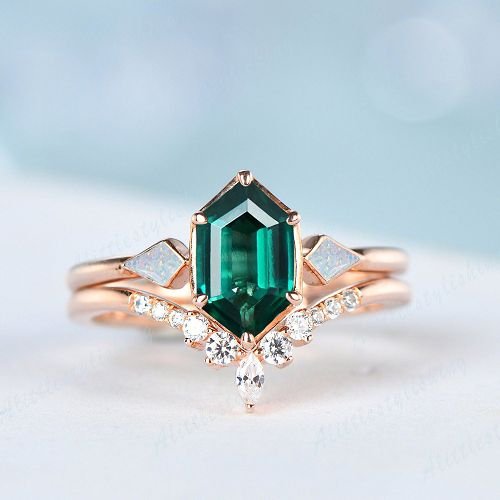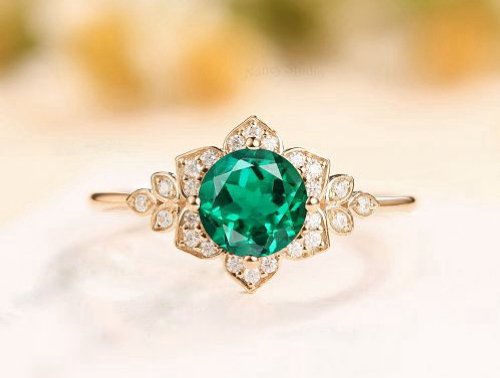What You Need to Know Before Buying Emerald Engagement Rings?

Introduction
When you choose an emerald engagement ring, you’re definitely showing a unique and individual style, as it’s a departure from the traditional diamond engagement ring. So, what should you prepare for mentally before making this choice? This article will guide you through the process of identifying natural emeralds, and introduce you to a more environmentally friendly option: lab-grown emerald rings. We aim to ensure your purchase journey is worry-free.
What is the Origin of Emerald Engagement Rings?
The first known instances of people wearing emerald rings on their left ring fingers go back to the Sumerians. They thought emeralds could reduce swelling, especially in the eyes. So, it was usual to wear emeralds on the left side and to present emerald rings, specifically made for the left hand, to those who had any swelling in or near their eyes. Throughout history and across the globe, emerald engagement rings have become a favorite choice. Over the years, Victorian style emerald rings and those inspired by old designs have become increasingly famous.

Emerald Engagement Ring Meaning
An emerald engagement ring holds a unique symbolism. Historically, the emerald gemstone symbolized deities in ancient cultures and held deep religious importance. It has been significant in different spiritual and cultural contexts across various societies.
Nowadays, emeralds symbolize a flourishing love. They are given to a loved one with the hope of fostering a stable and enduring love and commitment throughout their life together. Presenting an emerald in an engagement ring is akin to expressing wishes for good fortune, peace, and a long-lasting relationship in the upcoming marriage.
Understanding Emerald Grading
Emeralds are rated using the same four criteria as most gemstones: color, clarity, cut, and carat weight. Color is often the most critical factor in evaluating the quality of colored gemstones, including emeralds. However, for emeralds in particular, clarity is also a very important aspect to consider.
Color
We assess color by looking at the hue, saturation, and tone. Primarily, the hue should be green, though many emeralds also have touches of yellow and blue. To be classified as an emerald, the stone should have a medium to dark green tone. Those with a lighter tone are considered green beryl. A deep green, richly saturated emerald is more valuable and sought after than a lighter one because its intense color is rarer and more appealing.
Clarity
Emeralds are somewhat softer than other gemstones, rating about 8 on the Mohs hardness scale. For comparison, diamonds, which are the hardest, score a 10, while sapphires and rubies come in slightly lower at 9.
Because they’re softer, emeralds usually have more inclusions and surface imperfections. It’s very rare to find an emerald without any marks or fissures. Those perfect emeralds are often kept as investment pieces or family heirlooms, rather than being worn.
In fine jewelry, it’s normal and expected for emeralds to have several inclusions visible to the naked eye. These inclusions are graded on a scale from AAAA (Best), through AAA (Better), to AA (Good).
The number of inclusions affects the ‘mossy’ appearance of an emerald, which can reduce its transparency and clarity.
This phenomenon is sometimes called ‘jardin,’ which is French for ‘garden,’ referring to the inclusion patterns that resemble foliage.
Cut
Emeralds are most commonly shaped into the classic Emerald Cut, but you can also find them in oval forms. Other shapes, like round cuts, are less common with emeralds because their softer nature makes them more prone to chipping and they don’t reflect light as well.
Learn more: Emerald Wedding and Engagement Ring Guide: Popular Metals, Cuts, and Settings
Pointed shapes like pear or marquise are even rarer. This is because there’s a high risk of the stone breaking during the cutting process and chipping when worn.
The frequent presence of inclusions in emeralds is why you often see lower quality stones cut in a cabochon style, which is a dome shape with a flat bottom.

Carat
The carat weight of emeralds is measured like other gemstones. However, it’s also common to see emeralds sized in millimeters.
What to Consider When Purchasing an Emerald
When picking an emerald, color is key. Aim for a rich green shade with minimal yellow or blue. Clarity is also crucial. Look for a gem where inclusions don’t greatly affect its transparency. Don’t compare an emerald’s clarity to a diamond’s; they’re different, like apples and oranges. Even emeralds with many visible inclusions can be of excellent quality. Remember, nearly all emeralds are treated to enhance clarity. This doesn’t mean they’re lower quality, unlike in diamonds. We’re always here to help you find the perfect emerald!
If this article still doesn’t meet your needs, then you might find what you’re looking for in this other article: Emerald Engagement Ring: A Buying Guide
Should an emerald be chosen for an engagement ring?
Emeralds are undoubtedly gorgeous gems and look amazing on engagement rings. However, it’s important to know a few practical things about them before you decide to get one.
Emeralds are not as tough as diamonds, sapphires, or rubies.
As mentioned earlier, emeralds are softer compared to diamonds. They’re quite different in terms of hardness.
Gemstone hardness is measured on the Mohs scale, which ranges from 1 to 10. Diamonds are at the top with a score of 10, while emeralds vary between 7.5 and 8, depending on their type.
Although these numbers are close, the scale can be deceiving. In real-world use, diamonds are hundreds of times harder than emeralds, making them a more suitable choice for engagement rings.
Emeralds can still be worn daily, but they’re more likely to get scratched and become less clear over time than the other major gemstones like diamonds, sapphires, and rubies.

Limited Cut Options for Emeralds
Emeralds are not as hard as other gemstones often used in engagement rings, making it difficult to shape them into intricate designs. Additionally, due to their rarity and higher value compared to diamonds, fewer gem cutters are inclined to undertake more challenging cuts.
This leads to emeralds being primarily available in their classic ’emerald cut’. While oval and round cuts exist, they are more susceptible to damage over time.
Emeralds vs. Diamonds: Rarity and Cost
Emeralds are less common and typically more expensive than diamonds. While diamonds are one of the more abundant gemstones, high-quality emeralds are a rare find. As a result, emeralds of similar quality to diamonds often come with a higher price tag.
Sourcing Ethical Emeralds
Most of the world’s emeralds, about 50 to 95% depending on the year and quality, come from Colombia. Zambia also plays a significant role, contributing around 20% of the world’s gem-quality emeralds.
However, the mining practices in these countries have been problematic. Colombia has long faced civil unrest, and in Zambia, mine operators are being sued for causing severe pollution to local water supplies.
This makes the task of finding ethically sourced emeralds more challenging compared to other gemstones, but it’s not an impossible endeavor.
Ethical Emerald Mining and Lab-Grown Alternatives Small-scale ethical mines are present in both Colombia and Zambia. However, for greater assurance in ethical mining practices, Brazil is a recommended source.

For those seeking even more certainty about ethical sourcing, lab-grown emeralds are a good option.
One distinct advantage of mined emeralds is their traceability. Thanks to their unique features and chemical compositions, gemologists can often pinpoint the origin of an emerald with considerable accuracy. However, it’s worth noting that most emeralds sold by retailers don’t undergo this identification process.
If you still have numerous questions, then these are the most comprehensive answers to all:
Frequently Asked Questions: 47 Common Queries About Emerald Engagement Rings
FAQ: 45 Most Frequently Asked Questions About Emerald Engagement Rings
Lab-Grown Emeralds
The technology to cultivate emeralds in a laboratory has been around since the 1800s, but only recently has it become more cost-effective compared to mining.
Similar to lab-grown diamonds, lab-created emeralds are chemically and visually indistinguishable from natural emeralds. One of the easiest ways to recognize a lab-grown emerald is by its higher clarity, as the controlled lab environment allows for a less harsh formation process than in nature.
How are they grown?
Lab-grown emeralds are created using a method known as hydrothermal flux synthesis.
In this process, a beryl seed is placed in a sealed, pressurized container filled with minerals that naturally form emeralds. Heat and an electric charge are applied to simulate the natural conditions for emerald growth, allowing the emerald to gradually develop from the seed.
This method is time-consuming, with about 60 days required for just a millimeter of growth. Due to this slow growth rate, lab-grown emeralds are among the most expensive lab-created gemstones.
Clegit.com is a highly capable online store for creating and selling customized Jewelry. We offer customization services for all types of jewelry, including custom engagement rings, custom rings, custom pendant, custom earrings, custom bracelets, custom necklace, custom anklet, ect. If you have a preferred type and a specific design style in mind, please feel free to contact us. We are always ready to create a custom jewelry that fits you perfectly
Custom Jewelry
- Transparent Pricing: Silver Sold $0.
- Fit for Any Budget.
- Safeguarding Your Interests: Our Step-by-Step Pricing Approach ensures clarity.
- Worldwide Free Shipping: Your dream piece delivered to your doorstep.
- Expert Artistry: Skilled designers and handcrafted perfection.
- Certificate of Authenticity: Confirming the quality of metals and gemstones in your purchase.



